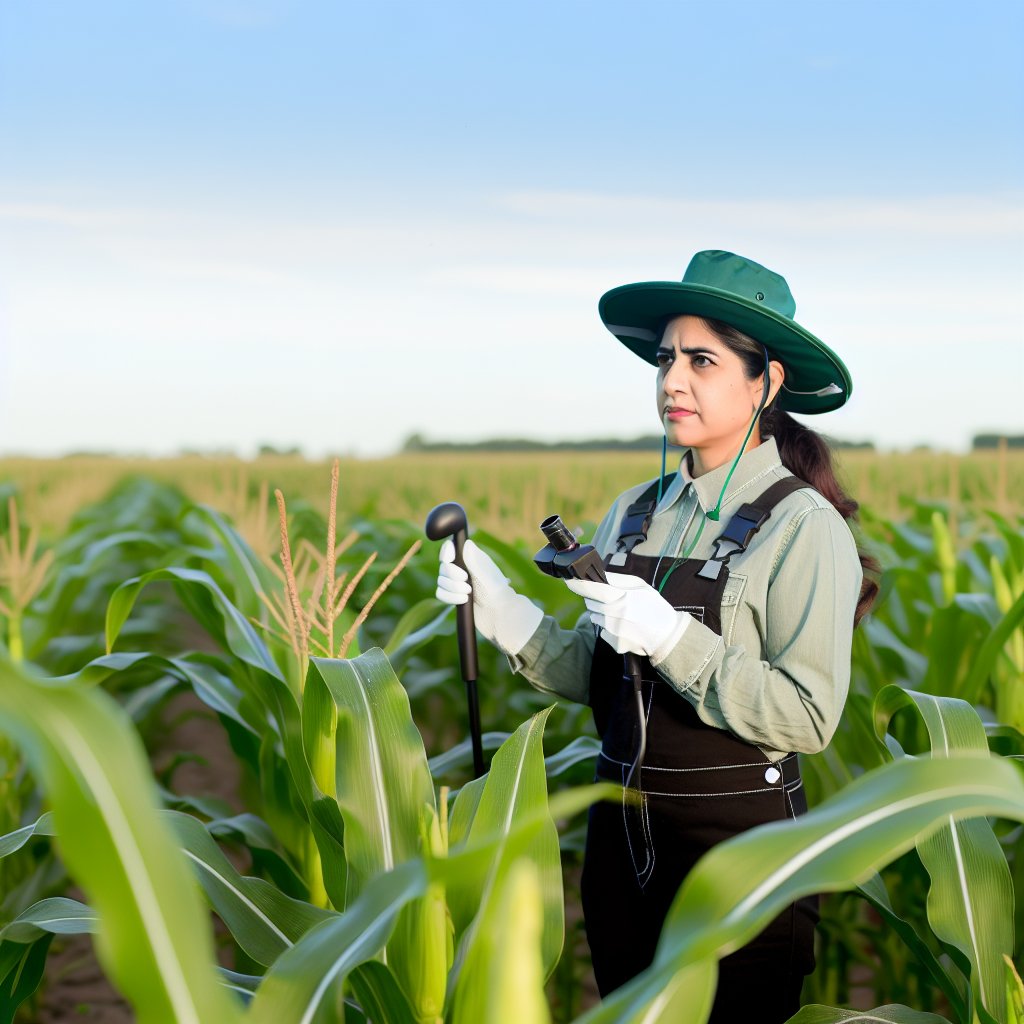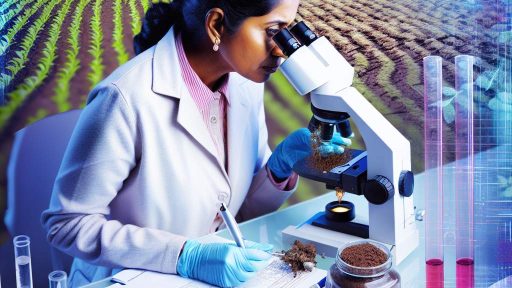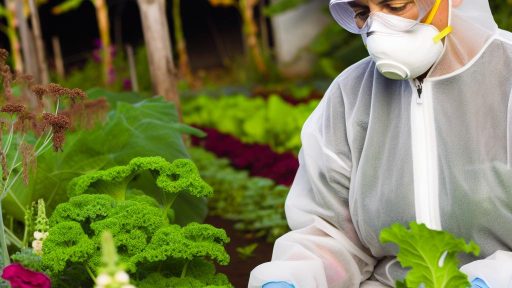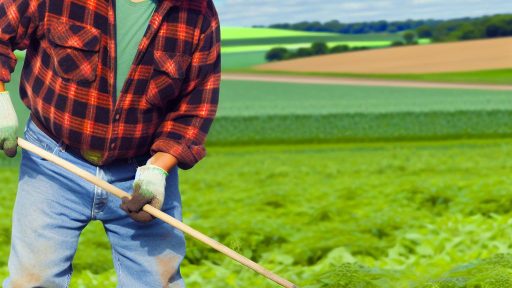Understanding the Importance of Early Crop Infection Detection for Yield Maximization
The Critical Role of Early Detection
Detecting crop infections early is essential for maximizing yields.
It allows farmers to implement treatments promptly.
This proactive approach minimizes crop loss and optimizes productivity.
Thus, staying ahead of potential threats is vital for success.
Reducing Crop Loss
Early infection detection significantly reduces crop loss.
Unfortunately, diseases can spread rapidly if not managed quickly.
By identifying problems early, farmers can take immediate action.
This includes applying fungicides or adjusting irrigation methods.
Enhancing Investment Returns
Effective early detection systems lead to higher investment returns.
Farmers can ensure their fields are healthy and productive.
When plants grow optimally, they yield more crops per acre.
Higher yields directly translate into increased profits.
Utilizing Technology in Detection
Modern technology aids in early detection of crop infections.
Drones and satellite imaging monitor crop health efficiently.
Additionally, soil sensors provide vital real-time data.
Transform Your Agribusiness
Unlock your farm's potential with expert advice tailored to your needs. Get actionable steps that drive real results.
Get StartedThese tools facilitate timely interventions to prevent losses.
Implementing Integrated Pest Management (IPM)
Integrated Pest Management strategies are crucial for farmers.
IPM promotes the use of multiple tactics for disease control.
This reduces reliance on chemical treatments, minimizing costs.
Ultimately, implementing IPM leads to healthier crops and higher yields.
Training and Education for Farmers
Education is key to recognizing the signs of early infections.
Farmers should participate in training programs and workshops.
This knowledge empowers them to act swiftly against threats.
Informed decisions can significantly improve crop health.
Monitoring Environmental Conditions
Environmental factors influence the likelihood of crop infections.
Farmers must monitor weather patterns and soil moisture levels.
Stress conditions can exacerbate disease susceptibility in crops.
Thus, adjustments should be made based on these observations.
Common Early Signs of Crop Infections
Visual Indicators to Look For
Recognizing early signs of crop infections can save farmers from significant losses.
Visual indicators serve as the first line of defense against widespread damage.
Discolored leaves are often the first sign of trouble.
Look for yellowing, browning, or wilting in plants, which could indicate stress.
Additionally, spots or lesions on the leaves can suggest various infections.
Watch for fungal spores on leaves or stems; their presence can be alarming.
Another key visual cue is stunted growth in crops.
Plants that fail to grow at the expected rate may suffer from root infections.
Moreover, changes in leaf texture, such as curling or wilting, deserve attention.
In extreme cases, fruit and vegetable surfaces may appear abnormal or decaying.
Common Symptoms to Monitor
Monitoring specific symptoms can help identify infections early.
Showcase Your Farming Business
Publish your professional farming services profile on our blog for a one-time fee of $200 and reach a dedicated audience of farmers and agribusiness owners.
Publish Your ProfileStains or discoloration may point to a bacterial or fungal presence.
Additionally, look for signs of pest infestations, such as holes in leaves.
These pests can transmit diseases, exacerbating crop issues.
Occasionally, distinct odors emanating from infected plants may be detectable.
This can signal rotting or severe infections requiring immediate investigation.
Furthermore, observe root systems; discoloration or mushiness alerts farmers to potential diseases.
Impact of Weather Conditions
Weather plays a crucial role in crop health and disease prevalence.
For example, high humidity levels may encourage fungal growth.
Cloudy weather can hinder photosynthesis, stressing plants and making them susceptible.
Heavy rainfall can lead to waterlogged conditions, promoting root rot.
Farmers should adjust their observation strategies based on weather patterns.
Being proactive during unpredictable weather can enhance crop resilience.
Technological Advances in Crop Monitoring
Drones in Agriculture
Drones provide a bird’s-eye view of farmland.
They enhance crop scouting by capturing high-resolution images.
This technology allows farmers to spot issues early.
Drones can identify nutrient deficiencies and pest infestations.
Moreover, they can cover large areas quickly and efficiently.
Sensor Technology
Sensors play a vital role in modern agriculture.
They monitor soil moisture, temperature, and nutrient levels.
This real-time data helps farmers make informed decisions.
Furthermore, they can be deployed in various environments.
With accurate input, farmers can enhance crop yields.
Artificial Intelligence in Crop Monitoring
Artificial intelligence (AI) transforms agriculture by analyzing data.
It detects patterns that farmers might miss with the naked eye.
AI systems can predict disease outbreaks before they spread.
Additionally, they optimize resource allocation, saving time and costs.
Through machine learning, these systems improve over time.
Integration of Technologies
Integrating drones, sensors, and AI enhances crop health monitoring.
This integration creates a comprehensive view of agricultural conditions.
Farmers benefit from actionable insights tailored to their fields.
Ultimately, this synergy leads to higher investment returns.
Learn More: Crop Diversification Methods to Improve Farmland Value
Integrated Pest Management (IPM): Combining Techniques for Effective Infection Control
Overview of Integrated Pest Management
Integrated Pest Management (IPM) is a holistic approach to crop protection.
This strategy combines various control methods for efficient infection management.
Farmers can enhance productivity while minimizing adverse environmental impacts.
Components of IPM
Effective IPM relies on several critical components.
- Monitoring pest populations to determine thresholds for intervention.
- Identifying beneficial organisms that help control pest populations.
- Employing cultural practices that promote healthy crops.
- Using biological controls where possible.
- Applying chemical controls judiciously and responsibly.
Benefits of Implementing IPM
IPM offers numerous advantages for modern agriculture.
Farmers can reduce their reliance on chemical pesticides.
Furthermore, it promotes sustainable farming practices.
IPM increases crop resilience against pests and diseases.
Showcase Your Farming Business
Publish your professional farming services profile on our blog for a one-time fee of $200 and reach a dedicated audience of farmers and agribusiness owners.
Publish Your ProfileMonitoring Techniques
Monitoring is essential to a successful IPM strategy.
Farmers should frequently check fields for signs of pest activity.
Observation techniques include visual inspections and trapping methods.
Data collected helps inform pest control decisions.
Cultural Practices for Pest Management
Cultural practices play a vital role in IPM.
Crop rotation disrupts pest life cycles effectively.
Planting pest-resistant varieties minimizes risk.
Maintaining healthy soil through proper nutrition supports healthy crops.
Biological Control Methods
Biological control uses natural enemies to manage pests.
Farmers can introduce beneficial insects like ladybugs and parasitoids.
These organisms prey on harmful pests, reducing their populations naturally.
Implementing biological controls fosters a balanced ecosystem on the farm.
Judicious Use of Chemical Controls
While IPM minimizes pesticide use, some situations may require chemical interventions.
Farmers should opt for targeted applications when necessary.
Choosing environmentally friendly products enhances sustainability.
Moreover, timing applications correctly is crucial for effectiveness.
Delve into the Subject: Greenhouse Leasing for Agricultural Property Owners
The Role of Soil Health in Preventing Crop Diseases
Importance of Soil Health
Soy health significantly affects crop productivity.
Healthy soil promotes strong plant growth and resilience.
Moreover, it plays a crucial role in disease prevention.
Factors that Influence Soil Health
Several factors determine soil health quality.
- Soin pH impacts nutrient availability.
- Organic matter supports beneficial microorganisms.
- Soil texture influences water retention and aeration.
Maintenance Practices for Healthy Soil
Regular maintenance enhances soil health.
Crop rotation prevents soil depletion and reduces pests.
Cover cropping also improves soil structure and fertility.
Soil Testing Techniques
Testing soil allows for informed management decisions.
Laboratory tests provide detailed nutrient profiles.
Additionally, soil tests indicate pH levels and organic matter content.
Consequently, farmers can adjust practices accordingly.
Utilizing Soil Amendments
Applying soil amendments boosts soil health.
Organic amendments like compost enrich nutrient levels.
Mineral fertilizers correct nutrient deficiencies effectively.
These strategies ultimately lead to healthier crops.
Monitoring Soil Health
Regularly monitoring soil health ensures sustainability.
Observations of microbial activity inform management practices.
Farmers should keep records to track improvements.
This approach fosters proactive disease management.
See Related Content: Integrating Precision Agriculture With Real Estate Strategies For Crop Success

Case Studies: Successful Early Detection Methods and Their Impact on Investment Returns
Introduction to Early Detection
Early detection methods play a crucial role in optimizing crop health.
They help identify infections before significant damage occurs.
This approach can lead to higher investment returns for farmland owners.
Showcase Your Farming Business
Publish your professional farming services profile on our blog for a one-time fee of $200 and reach a dedicated audience of farmers and agribusiness owners.
Publish Your ProfileCase Study: Smart Agriculture Solutions
Smart Agriculture Solutions implemented drone technology in Illinois.
Drones provided visual data for pest and disease monitoring.
As a result, farmers detected infections earlier than traditional methods allowed.
This approach improved crop yield by 20% in the first year alone.
Impact on Investment Returns
Increased crop yield directly translates to higher revenue.
Farmers who adopted drone technology saw profits increase significantly.
Moreover, reduced pesticide use lowered operational costs.
This change positively affected overall farmland investment returns.
Case Study: Precision Agriculture Techniques
Agritech Innovators utilized soil sensors in California vineyards.
The sensors monitored moisture levels and nutrient deficiencies.
Farmers received alerts for potential infection risks.
This proactive approach resulted in a 15% decrease in crop diseases.
Financial Gains from Precision Techniques
Less disease led to fewer crop losses and higher product quality.
Investment returns improved as customers paid more for premium grapes.
This method showcased the economic benefits of early intervention.
Implications of Improved Crop Monitoring
Implementing early detection methods enhances farmland investment prospects.
These case studies illustrate the tangible benefits of technology.
Investors should consider these methods for future profitability.
You Might Also Like: Greenhouse Expansion for Rural Land Investments
Farmers’ Best Practices: Strategies for Routine Monitoring and Crop Health Assessment
Importance of Routine Monitoring
Routine monitoring is essential for maintaining crop health.
It helps identify potential issues early on.
This proactive approach can significantly increase yields.
Moreover, it reduces the chances of widespread crop infections.
Utilizing Technology for Monitoring
Farmers can leverage technology for effective crop monitoring.
Drones can provide aerial views of fields.
This bird’s eye perspective helps in spotting irregularities.
Additionally, soil moisture sensors can track hydration levels accurately.
Farm management software enables comprehensive tracking of crop health.
Regular Field Inspections
Conducting regular field inspections is a tried-and-true method.
Farmers should assess crops physically for signs of distress.
Look for discoloration, wilting, or pest presence during inspections.
Timely action can prevent minor issues from escalating.
Emphasizing Soil Health
Healthy soil is fundamental to strong crop growth.
Farmers should regularly test soil quality and composition.
Soil amendments may be necessary to maintain optimal fertility.
Moreover, crop rotation can enhance soil health over time.
Utilizing Data for Decision Making
Data collection and analysis empower farmers to make informed decisions.
Use historical data to predict potential future issues.
Integrate weather forecasts to better plan planting and harvesting.
This strategic planning leads to reduced risks and higher returns.
Showcase Your Farming Business
Publish your professional farming services profile on our blog for a one-time fee of $200 and reach a dedicated audience of farmers and agribusiness owners.
Publish Your ProfileCommunity Resources and Collaboration
Farmers should engage with local agricultural experts and extension services.
These resources provide valuable insights and support.
Collaboration with other farmers can foster sharing of best practices.
Workshops can enhance skills in monitoring and assessment techniques.
Cost-Benefit Analysis: Investing in Early Detection Tools for Long-Term Profitability
Introduction to Early Detection
Investing in early detection tools can dramatically enhance crop management.
Farmers can minimize losses caused by diseases or pests.
Moreover, recognizing issues early leads to timely interventions.
Advantages of Early Detection Tools
Early detection tools significantly reduce economic risks for farmers.
These tools can help in optimizing resource allocations.
Additionally, farmers can plan their actions based on real-time data.
Financial Gains
Early detection can lead to improved yields and quality.
This improvement translates to higher market prices for crops.
As a result, farmers may see a substantial return on investment.
Reduction in Chemical Use
Implementing early detection can lower pesticide applications.
Farmers can apply chemicals more selectively and effectively.
This approach promotes environmental sustainability while minimizing costs.
Challenges of Implementing Early Detection Tools
Despite the benefits, challenges exist in adopting these tools.
The initial investment can be significant for small-scale farmers.
Training staff to use advanced technology can also pose difficulties.
Cost Considerations
Initial costs for early detection systems can deter investment.
Farmers must evaluate the cost against potential long-term savings.
Therefore, performing a thorough cost-benefit analysis is crucial.
Technological Barriers
Some farmers may lack access to necessary technology.
Moreover, technical support may be limited in rural areas.
Thus, partnerships with tech companies can enhance implementation.
Investment Potential in Early Detection
Investing in early detection tools offers significant potential for farmers.
Long-term profitability can outweigh initial challenges.
Ultimately, these tools significantly contribute to better crop management.
Additional Resources
Mungbean: A Preview of Disease Management Challenges for an …




